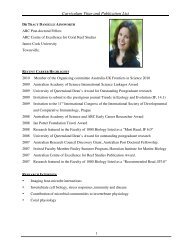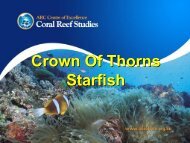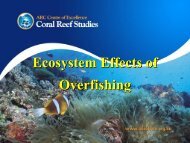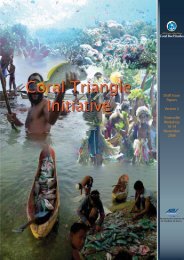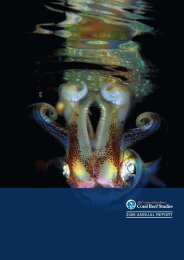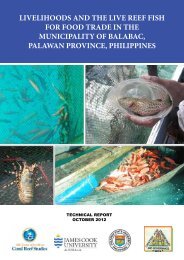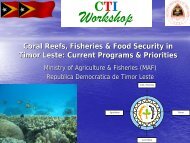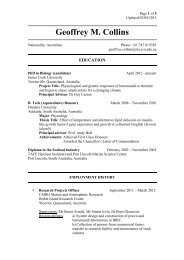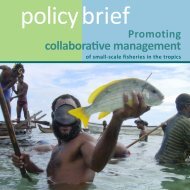Download - ARC Centre of Excellence for Coral Reef Studies
Download - ARC Centre of Excellence for Coral Reef Studies
Download - ARC Centre of Excellence for Coral Reef Studies
Create successful ePaper yourself
Turn your PDF publications into a flip-book with our unique Google optimized e-Paper software.
PublicationsJournal Articles[1] Abesamis, RA, Alcala, AC and Russ, GR(2006). How much does the fishery at ApoIsland benefit from spillover <strong>of</strong> adult fishfrom the adjacent marine reserve? FisheryBulletin 104(3): 360-375.[2] Abesamis, RA, Russ, GR and Alcala, AC(2006). Gradients <strong>of</strong> abundance <strong>of</strong> fishacross no-take marine reserve boundaries:evidence from Philippine coral reefs.Aquatic Conservation: Marine andFreshwater Ecosystems 16(4): 349-371.[3] Ainsworth, TD, Fine, M, Blackall, LL andHoegh-Guldberg, O (2006). Fluorescencein situ hybridization and spectral imaging<strong>of</strong> coral-associated bacterial communities.Applied and Environmental Microbiology72(4): 3016-3020.[4] Alcala, AC and Russ, GR (2006). Notakemarine reserves and reef fisheriesmanagement in the philippines: A newpeople power revolution. Ambio 35(5):245-254.[5] Almany, G and Webster, M (2006). Thepredation gauntlet: early post-settlementmortality in reef fishes. <strong>Coral</strong> <strong>Reef</strong>s 25(1):19-22.[6] Anthony, KRN (2006). Enhanced energystatus <strong>of</strong> corals on coastal, high-turbidityreefs. Marine Ecology Progress Series 319:111-116.[7] Ayling, BF, McCulloch, MT, Gagan, MK,Stirling, CH, Andersen, MB and Blake, SG(2006). Sr/Ca and 18O seasonality in aPorites coral from the MIS 9 (339–303 ka)interglacial. Earth and Planetary ScienceLetters 248(1-2): 462-475.[8] Baird (2006). Myth <strong>of</strong> green belts. Samudra44: 14-19.[9] Baird, AH, Salih, A and Trevor-Jones, A(2006). Fluorescence census techniques <strong>for</strong>the early detection <strong>of</strong> coral recruits. <strong>Coral</strong><strong>Reef</strong>s 25(1): 73-76.[10] Ball, EE and Miller, DJ (2006). Phylogeny:The continuing classificatory conundrum<strong>of</strong> chaetognaths. Current Biology 16(15):R593-R596.[11] Barnett, A, Bellwood, DR and Hoey,AS (2006). Trophic ecomorphology <strong>of</strong>cardinalfish. Marine Ecology ProgressSeries 322(1): 249-257.[12] Bay, LK, Buechler, K, Gagliano, M andCaley, MJ (2006). Intraspecifi c variationin the pelagic larval duration <strong>of</strong> tropicalreef fishes. Journal <strong>of</strong> Fish Biology 68(4):1206-1214.[13] Bay, LK, Crozier, RH and Caley, MJ (2006).The relationship between populationgenetic structure and pelagic larvalduration in coral reef fishes on the GreatBarrier <strong>Reef</strong>. Marine Biology 149(5): 1247-1256.[14] Bellwood, DR, Hoey, AS, Ackerman, JLand Depczynski, M (2006). <strong>Coral</strong> bleaching,reef fish community phase shifts and theresilience <strong>of</strong> coral reefs. Global ChangeBiology 12(9): 1587-1594.[15] Bellwood, DR, Hughes, TP and Hoey, AS(2006). Sleeping functional group drivescoral-reef recovery. Current Biology 16(24):2434-2439.[16] Bellwood, DR, Wainwright, PC, Fulton,CJ and Hoey, AS (2006). Functionalversatility supports coral reef biodiversity.Proceedings <strong>of</strong> the Royal Society B-Biological Sciences 273(1582): 101-107.[17] Berkelmans, R and van Oppen, M (2006).The role <strong>of</strong> zooxanthellae in the thermaltolerance <strong>of</strong> corals: a "nugget <strong>of</strong> hope" <strong>for</strong>coral reefs in an era <strong>of</strong> climate change.Proceedings <strong>of</strong> the Royal Society B:Biological Sciences 273(1599): 2305-2312.[18] Berkes, F, Hughes, TP, Steneck, RS,Wilson, JA, Bellwood, DR, Crona, B, Folke,C, Gunderson, LH, Leslie, HM, Norberg,J, Nystrom, M, Olsson, P, Osterblom,H, Scheffer, M and Worm, B (2006).Globalization, roving bandits, and marineresources. Science 311(5767): 1557-1558.[19] Bernal, JP, Eggins, SM, McCulloch, MT,Grun, R and Eggleton, RA (2006). Dating <strong>of</strong>chemical weathering processes by in situmeasurement <strong>of</strong> U-series disequilibria insupergene Fe-oxy/hydroxides using LA-MC-ICPMS. Chemical Geology 235(1-2):76-94.[20] Berumen, ML and Pratchett, MS (2006).Recovery without resilience: persistentdisturbance and long-term shifts in thestructure <strong>of</strong> fish and coral communities atTiahura <strong>Reef</strong>, Moorea. <strong>Coral</strong> <strong>Reef</strong>s V25(4):647-653.[21] Brachert, TC, Reuter, M, Kroeger, KF andLough, JM (2006). <strong>Coral</strong> growth bands: Anew and easy to use paleothermometerin paleoenvironment analysis andpaleoceanography (late Miocene, Greece).Paleoceanography 21: PA4217.[22] Carpenter, SR and Folke, C (2006). Ecology<strong>for</strong> trans<strong>for</strong>mation. Trends in Ecology &Evolution 21(6): 309-315.[23] Ceccarelli, DM, Hughes, TP andMcCook, LJ (2006). Impacts <strong>of</strong> simulatedoverfishing on the territoriality <strong>of</strong> coralreef damselfish. Marine Ecology ProgressSeries 309: 255-262.[24] Chapin, FS, Hoel, M, Carpenter, SR,Lubchenco, J, Walker, B, Callaghan, TV,Folke, C, Levin, SA, Maler, KG, Nilsson, C,Barrett, S, Berkes, F, Crepin, AS, Danell,K, Rosswall, T, Starrett, D, Xepapadeas, Aand Zimov, SA (2006). Building resilienceand adaptation to manage Arctic change.Ambio 35(4): 198-202.[25] Cinner, J, Marnane, MJ, McClanahan, TRand Almany, GR (2006). Periodic closuresas adaptive coral reef management in theIndo-Pacific. Ecology and Society 11(1).[26] Cinner, JE and McClanahan, TR(2006). Socioeconomic factors thatlead to overfishing in small-scale coralreef fisheries <strong>of</strong> Papua New Guinea.Environmental Conservation 33(01): 73-80.[27] Davy, SK, Burchett, SG, Dale, AL, Davies,P, Davy, JE, Muncke, C, Hoegh-Guldberg,O and Wilson, WH (2006). Viruses: agents<strong>of</strong> coral disease? Diseases <strong>of</strong> AquaticOrganisms 69: 101-110.44



